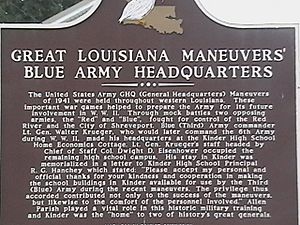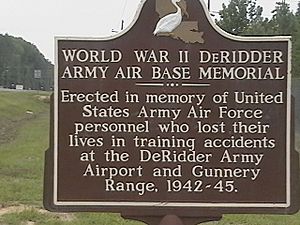Louisiana Maneuvers facts for kids

The Louisiana Maneuvers were a series of very large training exercises for the U.S. Army. They took place in 1941 in northern and west-central Louisiana. This area was near the Sabine River to the west, the Calcasieu River to the east, and the city of Shreveport to the north. Important military bases like Fort Polk, Camp Claiborne, and Camp Livingston were also in this region.
About 400,000 soldiers took part in these exercises. Their main goal was to test how well the U.S. Army was training its troops. They also checked how supplies were moved, how military plans worked, and how well commanders led their units. Similar large training events happened in 1941, like the Arkansas Maneuvers and the Carolina Maneuvers.
Many Army officers who participated in these maneuvers later became very important leaders in World War II. These included famous generals like Omar Bradley, Mark Clark, Dwight D. Eisenhower, Walter Krueger, Joseph Stilwell, and George Patton.
Why the Maneuvers Happened
When Nazi Germany invaded Poland in 1939, World War II began. At that time, the U.S. Army was much smaller than European armies. Most of its soldiers were infantry, meaning they fought on foot. Only a few units had vehicles or machines.
As war seemed more likely, the U.S. Army needed to get bigger and more modern. It also needed to practice large-scale operations. This would help them test all parts of their fast-growing but inexperienced force. General George C. Marshall, who was the Army's top leader, put General Lesley McNair in charge of training.
General McNair and Colonel Mark Wayne Clark chose thousands of acres of empty land in Louisiana. They thought it was a great place for big training exercises. These war games happened while Britain was expecting a German invasion. Some people thought the National Guard units involved might not go home afterward.
How the Exercises Worked
About 400,000 soldiers were split into two make-believe armies. These armies represented two fake countries. One was called Kotmk (for Kansas, Oklahoma, Texas, Missouri, Kentucky), also known as the Red Army. The other was Almat (for Arkansas, Louisiana, Mississippi, Alabama, Tennessee), or the Blue Army. Together, they formed 19 different military divisions.
From August to September 1941, the war game covered about 3,400 square miles (8,800 square kilometers) of Louisiana. The area was bordered by the Sabine River to the west and the Calcasieu River to the east. To the north, it reached the Red River near Shreveport. The two fake countries were "at war" over rights to the Mississippi River.
The Louisiana Maneuvers had two main parts, called phases.
- Phase 1: Both sides were given missions to attack. The Red 2nd Army was supposed to cross the Red River and invade the Blue homeland. The Blue 3rd Army would move north to stop them and push the Red forces back.
- Phase 2: In this phase, the Blue Army was twice as big as the Red Army. It also had its own armored division, the 2nd, which had switched sides from Phase 1. Blue's mission was to attack and capture Shreveport, Louisiana. The Red force was much smaller. Its job was mostly to defend a 100-mile zone south of the city.
The Blue Army won the exercises. This was mainly thanks to General George S. Patton, who led the Blue 2nd Armored Division.
Omar Bradley, another general who took part, later said that the people of Louisiana welcomed the soldiers. Some soldiers even slept in residents' homes. Bradley mentioned that sometimes it was so crowded, there was hardly room to walk. He also noted that a few troops were disrespectful to the residents' land and crops. They would sometimes take crops for extra food. However, for the most part, soldiers and residents got along well.
Sadly, 26 men died during the exercises. Most of them drowned in the Sabine River or were in vehicle accidents. One soldier was struck by lightning, and another had a heart attack at just 24 years old.
These exercises also led to the creation of Fort Polk. This military base was named after Leonidas Polk, a Confederate General.
What the Army Learned
The U.S. Army's fighting plans were based on the ideas of using large numbers of troops and moving quickly. The Army had learned from its past, like the fast movements of frontier soldiers and the large forces used in the U.S. Civil War. These ideas shaped how the U.S. Army planned to fight in World War II.
The 1st U.S. Armored Division, which was a very large unit with tanks and other vehicles, tested many things. It checked if such a big unit could travel long distances. It also tested if troops and vehicles could keep fighting in tough conditions. The armored division idea proved to be good. This led to the creation of 16 U.S. armored divisions during World War II.
The U.S. Army also wanted to learn how to stop German blitzkrieg attacks. These were fast attacks with many tanks. The maneuvers tested a new idea called the tank destroyer. These were highly mobile guns kept in reserve. When enemy tanks attacked, these guns would quickly move to the sides of the attack. Their goal was to destroy many enemy tanks. Tank destroyers were supposed to use quick, hit-and-run tactics.
The data from the Louisiana Maneuvers showed that the infantry's anti-tank guns actually destroyed more "enemy" tanks. However, the Army still decided to create special independent tank destroyer battalions.
In World War II, large enemy tank attacks like those imagined rarely happened. Only one tank destroyer battalion ever fought in a battle exactly as planned, at the Battle of El Guettar. After the war, the tank destroyer force was ended. The job of fighting tanks went back to the infantry, engineer, and armor units.
The exercises were also important for testing the new C ration. This was a type of packaged meal for soldiers. The Army gathered important information about the weight of the meals and the design of the cans. Changes were made based on this data. This led to the standard "C" field ration used by U.S. ground forces for most of World War II.



